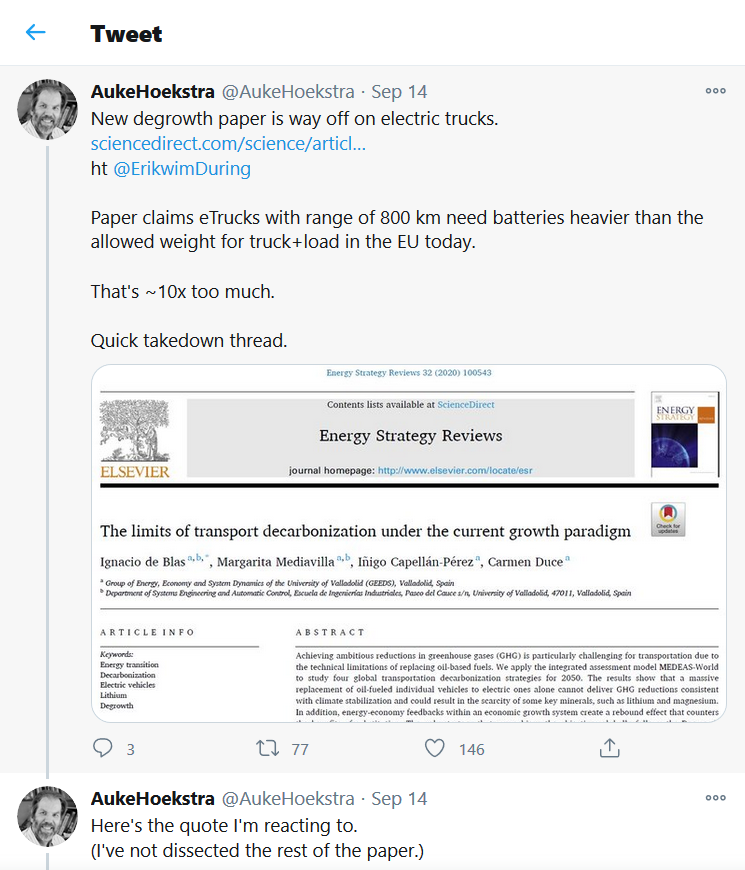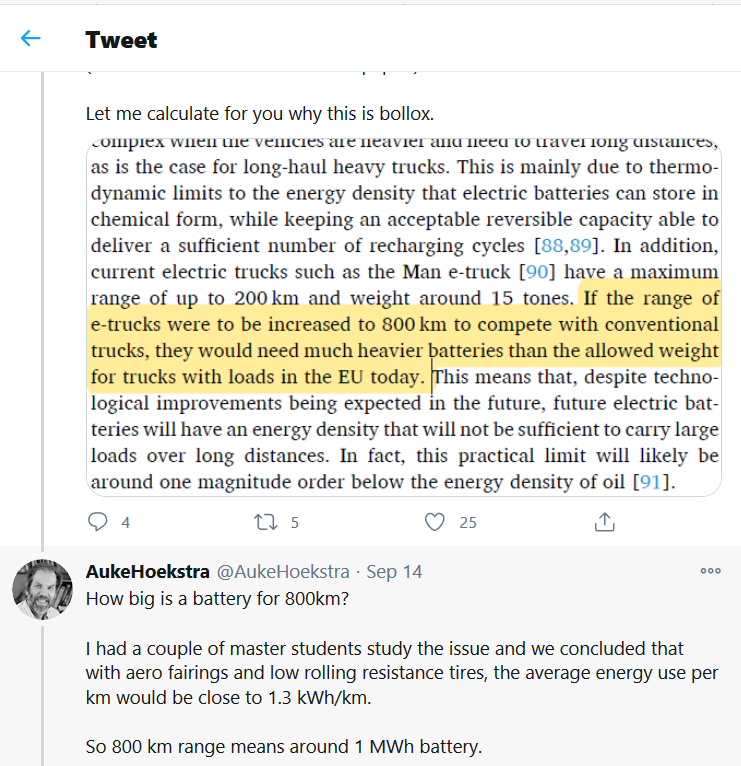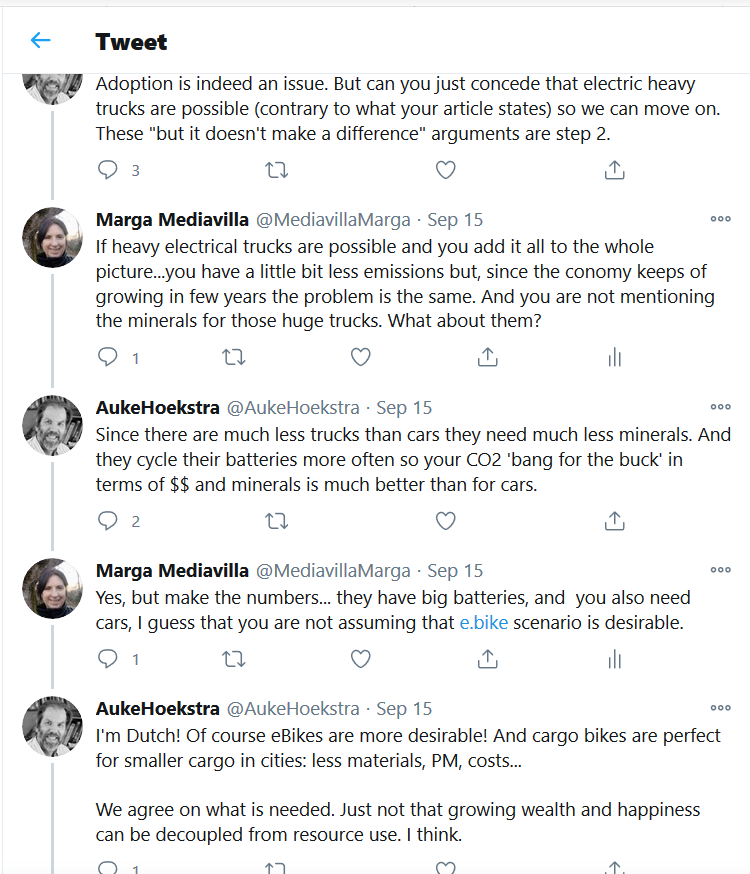A few weeks ago we published our article (“The limits of transport decarbonization under the current growth paradigm”) “What does decarbonizing transport actually mean?” in which we showed some results obtained with our MEDEAS model on the limits of technological solutions when it comes to achieving the reductions in greenhouse gas emissions that are necessary to avoid a climate catastrophe.
The article had an important response on social networks, especially on Twitter, with very favourable comments and also with very harsh criticism. One of the things that has been most criticized has been a detail that we do not believe is excessively relevant in the face of the general model, but which has generated a lot of controversy: the fact that our policies do not consider the option of purely electric trucks as something viable on a large scale before 2050. Therefore, we have decided to write this post with our response to the criticisms received after carefully reviewing the technical data on which we rely (which has taken some time).
Previous considerations
Before we start with technical data we would like to clarify an important aspect about our results. In the models that we have developed to date, we have chosen to include only those technologies that are currently in commercial exploitation, not including those that are still in the experimental and prototype phase. In more than ten years that we have been studying the energy question, we have seen many “revolutionary” technologies that promised to save us from the energy crisis pass through the pages of newspapers. And we have also seen how, once in the market and under real operating conditions, almost all of them have turned out to be much more mediocre than what was announced with great fanfare in the media.
Since 2005 we have seen talk of the nuclear renaissance, the biofuels, the DESERTEC project, the CO2 capture and sequestration, fusion, algae, graphene… and we have seen how, years later, when these technologies arrive the market (if they do arrive at all), the results are much more mediocre than what was announced in the big headlines.
For all these reasons, we believe that the most responsible position when evaluating energy policies is to be cautious with new technological developments as we try to do in our studies. We understand that this comes as a shock to those who are exclusively dedicated to technical research and see laboratory data that is several times more optimistic than the data we use in our simulations. We do not deny that such data are real in the context of research, but we believe that they are not the data that should be used when doing large-scale studies, because there are many other variables besides techniques that come into play when it comes to knowing whether a technology is going to be applied in all kinds of uses, economic sectors or regions of the world.
In addition to the technical results, we must study the economic, ecological and social conditioning factors. And, above all, we must not forget that the most important thing in the energy transition is the variable of time. Technologies that start to give interesting results at the prototype level must go through long periods until they are adopted by consumers on a large scale. We have seen that personal electric vehicles launched their first models in the 1990s and only now do they seem to be considered a purchase option by consumers. For this reason alone, and given that our simulations span three decades, the reluctance to consider purely electric heavy-duty trucks as a major option in the energy transition before 2050 would be justified.
In any case, let us discuss the technical data we have used to make this estimate, in response to certain criticisms we have received on social networks these days.
Answer to Auke Hoekstra
One of the Twitter threads that has most strongly criticized our study has been that of Auke Hoekstra (@AukeOekstra) a researcher at Eindhoven University of Technology’s. Specifically, he has focused on the paragraph of our article in which we say:
“In addition, current electric trucks such as 27 the Man e‐truck (MAN Truck & Bus, 2020) have a maximum range of up to 200 km and weight 28 around 15 tones. If the range of e‐trucks were to be increased to 800km to compete with conventional trucks, they would need much heavier batteries than the allowed weight for trucks with loads in the EU today.”[1]
On the basis of this paragraph alone, Hoekstra dismisses the entire study, without commenting on any other (many) aspects, and concludes that we “the defenders of Degrowth” rely on outdated data to defend our choices, which are merely ideological. This should not be the way to deal with studies as systemic as the one we present in that article, because one detail does not change the structural tendencies of a system.
Nevertheless, we will study in detail the technical data on which his criticism is based. Hoekstra argues that we have assumed a battery size 10 times larger than that needed for electric trucks and states: “well designed modern, low emission heavy eTrucks with 800km of range are less than 2 tonnes (5%) heavier than diesel equivalents[2]” .
In order to give these results he relies on two assumptions:
- Battery density of 400 Wh/kg
- Truck consumption of 1.3 kWh/km.
Density of the batteries
Nowadays, the energy densities of the most expensive batteries reaches 260 Wh/kg. Hoekstra argues that the density can go up to 400 Wh/kg and assumes that the auxiliary elements of the storage system add approximately 30% of weight, so the density of the entire power system is estimated at 300 Wh/kg.
We do not know if the density of lithium batteries will be able to reach that value of 400 Wh/kg in the future, future technical developments are uncertain, although there may be studies that give those values. What we do know is that the reality of heavy electric vehicles is far from these values. This is partly because heavy vehicles tend to use inexpensive, long-life and reliable batteries to prevent the cost of their prototypes from skyrocketing, since they use relatively many more batteries than light vehicles. Mercedes Benz’s electric bus, for example, it uses state-of-the-art solid electrolyte batteries without cobalt and nickel of 140 Wh / kg, which will be cheaper in the future than those that will have these minerals and would allow it to reach higher densities.
This density is almost three times smaller than that assumed by Hoekstra, I imagine that in the future because the current data does not show this but rather reinforces our thesis. When can we expect such efficient batteries to be available on the market at affordable prices? As we discussed in previous paragraphs, our studies are not based on laboratory data but on realistic projections of improvement of the models currently on the market, because it is necessary to take into account the delays, the temporal evolution of the markets and the socioeconomic conditions.
Consumption of trucks
The consumption that Hoekstra estimates is also optimistic, although a little more moderate. He assumes that the consumption of an electric truck is 1.3 kWh/km, assuming that it has very high efficiency wheels and aerodynamic design.
There are only a few prototypes of electric trucks on the market, but to find out the current consumption, we can take data from the DAF “CF Electric”, a 40 tonne electric tractor truck that reported 1.7 kWh per kilometer in tests carried out on flat ground in urban areas of the Netherlands. This consumption is 30% higher than Hoekstra estimates. A similar data is found in the announcement of the production of the electric truck Nikola Tre for 2021 which has 720 kWh in batteries for 400 km of autonomy, resulting in 1.8 kWh per kilometer. We do not know what consumption these trucks could have in rural areas of Asturian, Pakistani or Peruvian roads, but, clearly, consumption will be significantly higher, so we are not being overly pessimistic if we take this current theoretical value as a realistic value for the coming years.
On the other hand, it is not so easy to achieve the efficiency improvements it proposes. Low rolling resistance wheels present problems of lack of adherence, especially at low temperatures. Nor is aerodynamic design so easy to achieve. In the EU, trucks are flat-headed due to the size limitations imposed by regulations. In spite of its worse aerodynamic behaviour and higher consumption, the flat head optimises the ratio of transported load to energy consumption under current conditions. The size limitations of EU trucks, we guess, are based on important reasons, probably due to road and city design. Therefore, in order to opt for aerodynamic heads, trucks would have to sacrifice part of their load/consumption ratio, which would also worsen the net consumption of the vehicle, i.e. the consumption in relation to the kg of transported load.
Long distance alternatives
We have seen that the data that Hoekstra has used is quite optimistic in relation to current capabilities, so it is not surprising that he obtains an efficiency 10 times higher than ours. But let’s now discuss the specific question that he criticizes, because it is also a question that is particularly relevant: if electric trucks can replace current ones for long distances and high loads. This requires that we face a problem of great interest for the future of transport: the relationship between the weight of the truck (with its batteries) and the load it is capable of carrying.
We are going to do some numbers to find out the capacity and weight of the battery we would need for an electric truck to have the same autonomy as its diesel equivalent. A 40-ton (GTW) Gross Train Weight diesel truck has an autonomy of between 1,300 and 2,500 km (with single or double fuel tanks with capacities of 400 to 750 litters of diesel and average consumption of 30 litters/100 km). Since the recharging of its batteries requires very special infrastructures, the autonomy of an electric truck is much more critical than that of a diesel oil change. These trucks would run very significant risks of getting stuck in the middle of the roads if they made daily trips close to the maximum capacity of their batteries. The legislation allows for 9-hour driving days in two 4.5-hour periods, which correspond to trips of about 800 km in a single day. A range of 800 km as promised by the Tesla company would be very tight and would not leave any capacity to react to any unforeseen event. Therefore, it seems reasonable to think that the minimum autonomy that an electric truck should have to be driven with the same working hours and transport times as the current diesel trucks should be about 1,300 km.
We can assume the consumption of 1.7 kWh per kilometer of the DAF truck “CF Electric” mentioned above (even if it is on the flat). For energy density we can look at the Mercedes-Benz eCitaroG bus with 140 Wh/kg.
Therefore, to equalize the autonomy of 1,300 km-2,500 km of a diesel long-distance truck with an electric one that consumes 1.7 kWh / km, we would need 2,210 kWh-4,250 kWh batteries, weighing between 16 and 30 tons that added together the weight of the cabin (about 7.5 Ton) would prevent all the batteries from being carried in the tractor unit and would have to be shared with the semi-trailer. The normal weight of the cabin plus the semi-trailer is 15 Ton for the typical diesel 5 axle truck of 40 tons of (GTW) Gross Train Weight, so the payload it can carry is around 25 Ton, if you subtract between 16 and 30 Ton of batteries or you have nothing left to transport or very little.
These numbers are approximate because the weight of the rest of the truck’s systems should also be taken into account, but we do not believe, for the moment, that in view of these numbers the transport companies are going to get too excited because the benefits are very scarce. This does not mean that the density of the batteries cannot improve in the future, but, with these starting numbers, we do not predict that the entry into the market of these vehicles will grow exponentially, therefore, it will take a lot of time to see these trucks massively in the roads.
The volume of the batteries would not be negligible either: between 19 m³ -36 m³ of batteries that we can compare with the maximum volume of 80 m³ that a 40 GTW ton truck can carry. Moreover, the price, would not be very attractive since, while the equivalent diesel truck would cost between 70,000 and 100,000 euros, only a 2,210 kWh battery already costs more than 200,000 euros (if we use the price of 100 euros per kWh that they predict for the near future).
Battery charging would also be a problem. For example, a driver who owns a truck with a 100 kW fast home charger would need about 22 hours to fully charge a 2,210 kWh battery of liquid electrolyte because in the case of the solid electrolyte battery that we have chosen before it would take 5 times as long (110 hours). Of course, the charging process could be accelerated by using more power but at the cost of reducing the useful life of the batteries. In addition, in order to have higher power chargers that would reduce these charging times, it would need business recharging points that could easily require several MW of power for a few trucks, a power similar to that of transformation centers. A transport company with many trucks should have to be located near an electric substation or build its own, due to the enormous electrical power it would need to charge the trucks. This infrastructure also increases the price of the truck and, above all, makes its widespread implementation very difficult and delays it enormously. Finally, Hoekstra does not mention the limits of the minerals used in the batteries of the electric trucks. Our scenarios already found that the reserves of several minerals critical for high density batteries are depleted (an, in some of them, the total resources as well), therefore, the introduction of electric trucks will worsen this depletion and make those scenarios even more unrealistic.
In short, it would not be strictly impossible to build this type of long-distance truck, but its profitability is questionable since, in order for the weight of the batteries not to make them inoperative, they would have to reduce their autonomy and increase their travel times with respect to current ones. All this makes us fear that, although it is not impossible to have long-distance electric trucks on our roads, this is not the most likely option, especially in the short and medium term. We fear that, in this respect, Bill Gates’ opinion https://www.gatesnotes.com/Energy/Moving-around-in-a-zero-carbon-world is more accurate than Elon Musk’s.
Our experience tells us that, in a decarbonized scenario, the most suitable means of transport for long distances is electric railroads combined with electric trucks or vans for urban delivery (with autonomies similar to those of the prototypes now coming onto the market) or with biogas vehicles for rural areas.
In any case, all the results of our studies conclude that technological solutions are only one aspect of the problem and we cannot try to solve a global and systemic crisis by solving only one particular aspect of it. Any minimally systemic analysis shows that a truly significant reduction in greenhouse gas emissions requires the stabilization of economic activity and human population. It is difficult not to reach this conclusion when one does not fall into the usual reductionism of making only technical calculations without taking into account further social or ecological considerations and taking the best possible case. Fortunately, the cultural changes that have taken place in these decades are making the human population already begin to stabilize, hopefully humanity will also begin to understand that the stabilization of the economy is possible before we have to bear the worst consequences of climate chaos, ecological collapse and mineral depletion.
[1] “Furthermore, electric trucks such as the electronic Man truck (MAN Truck & Bus, 2020) have a maximum range of up to 200 km and weigh 28 about 15 tons. If the range of electronic trucks were increased to 800 km to compete with conventional trucks, they would need batteries much heavier than the weight allowed for loaded trucks in the EU today ”.
[2] Modern, well-designed, low-emission electric heavy-haulage trucks with 800 km range ranges are less than 2 tonnes (5%) heavier than their diesel equivalents.
A part of the Twitter debate:







